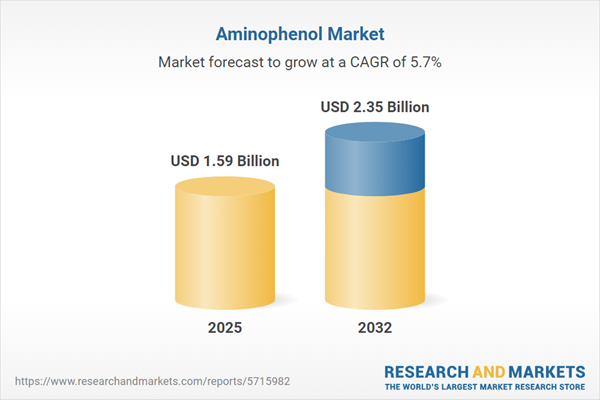Speak directly to the analyst to clarify any post sales queries you may have.
The aminophenol market is experiencing significant change as senior decision-makers adapt to evolving regulations, technology upgrades, and increasing supply chain complexity. Organizations are recalibrating their strategies to uphold compliance and drive operational flexibility in response to new industry pressures.
Market Snapshot: Aminophenol Market Size and Growth Trajectory
Globally, the aminophenol market is valued at USD 1.51 billion and advancing at a compound annual growth rate (CAGR) of 5.69%. Market projections indicate it will reach USD 1.59 billion in 2025 and USD 2.35 billion by 2032. Sustainable growth stems from ongoing demand in core sectors such as pharmaceuticals, agrochemicals, and textiles, where aminophenol serves as a key intermediate. Companies continue expanding capacities, enhancing product portfolios, and refining management to address shifting regulations and evolving customer needs.
Scope & Segmentation: Comprehensive Analysis of the Aminophenol Market
This report delivers a detailed overview of sector trends and opportunities for growth throughout the aminophenol value chain, structured to inform targeted strategic choices.
- End Use Applications: Pharmaceutical manufacturing, agrochemical synthesis, dye and pigment production, and specialty polymer manufacturing rely on aminophenol due to its adaptability and reliable performance across demanding processes.
- Product Types: M Aminophenol, O Aminophenol, and P Aminophenol are leveraged according to precise research and production requirements, supporting industry-specific applications and custom formulations.
- Form Factors: Powder and solution formats facilitate tailored supply options, providing operational flexibility for diverse manufacturing environments and logistics frameworks.
- Purity Levels: Analytical, industrial, and technical grades offer businesses the means to align product selection with both regulatory requirements and internal quality demands.
- Sales Channels: Direct purchasing and distributor-mediated models give organizations the means to optimize their procurement strategies for reliability and responsiveness to local market dynamics.
- Key Regions: Activity is distributed across the Americas, Europe, Middle East & Africa, and Asia-Pacific, with China and India displaying rapid momentum attributed to regulatory incentives, access to raw materials, and growing industrial bases driving regional influence.
- Key Players: Major participants include BASF SE, Dow Inc., Evonik Industries AG, Eastman Chemical Company, Huntsman International LLC, Merck KGaA, Aceto Corporation, Tokyo Chemical Industry Co., Ltd., ZuChem Inc., and Jiangsu TeYang Chemicals Co., Ltd. These firms provide a stable foundation for innovation and infrastructure development across international markets.
Key Takeaways for Senior Decision-Makers
- Organizations are prioritizing sustainable procurement and responsible manufacturing to align operations with tighter environmental policies and enhance long-term supply security.
- Investment in digital manufacturing technologies is enabling improved process control and agile responses to both regulatory adjustments and shifts in client expectations.
- Diversifying sourcing and production sites strengthens resilience, minimizing operational disruption from regulatory differences or global instability.
- Strategic collaborations between buyers and suppliers foster accelerated innovation in both products and processes, especially in high-value industries such as pharmaceuticals and colorants.
- Scalable and flexible manufacturing systems support dynamic cost management and make it possible to quickly adjust output by geography or application focus.
- Transparent supplier relationships and the application of lifecycle assessments in procurement decisions are helping organizations keep pace with evolving sustainability benchmarks.
Tariff Impact and Global Trade Dynamics
Changes in tariff frameworks—particularly those emerging in the United States—are driving aminophenol producers and buyers to reassess sourcing practices and configure resilient supply networks. By investing in local production capabilities, companies are better able to mitigate trade policy volatility and sustain robust supplier relationships.
Methodology & Data Sources
This analysis is built upon direct executive interviews, examination of international trade flows, and reviews of technical documents and industry materials. Findings are cross-verified, providing decision-makers with guidance that aligns with established industry best practices and supports precise strategy formulation.
Why This Report Matters
- Enables procurement and executive leaders to anticipate regulatory changes, reinforcing supply chain resilience and ensuring continued compliance.
- Delivers practical insights for integrating automation, digital platforms, and environmental initiatives into core planning.
- Supports executive teams in identifying and implementing partnership strategies that address new policy and market requirements, enhancing readiness for future industry shifts.
Conclusion
Addressing regulatory, technological, and supply chain changes proactively empowers organizations to capture emerging opportunities in the aminophenol market. Strategic action will enable businesses to successfully navigate complexity and sustain a strong competitive position as industry landscapes develop.
Additional Product Information:
- Purchase of this report includes 1 year online access with quarterly updates.
- This report can be updated on request. Please contact our Customer Experience team using the Ask a Question widget on our website.
Table of Contents
3. Executive Summary
4. Market Overview
7. Cumulative Impact of Artificial Intelligence 2025
Companies Mentioned
The companies profiled in this Aminophenol market report include:- BASF SE
- Dow Inc.
- Evonik Industries AG
- Eastman Chemical Company
- Huntsman International LLC
- Merck KGaA
- Aceto Corporation
- Tokyo Chemical Industry Co., Ltd.
- ZuChem Inc.
- Jiangsu TeYang Chemicals Co., Ltd.
Table Information
| Report Attribute | Details |
|---|---|
| No. of Pages | 198 |
| Published | November 2025 |
| Forecast Period | 2025 - 2032 |
| Estimated Market Value ( USD | $ 1.59 Billion |
| Forecasted Market Value ( USD | $ 2.35 Billion |
| Compound Annual Growth Rate | 5.6% |
| Regions Covered | Global |
| No. of Companies Mentioned | 11 |









